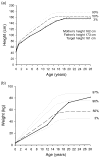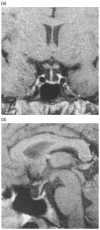A unique case of combined pituitary hormone deficiency caused by a PROP1 gene mutation (R120C) associated with normal height and absent puberty
- PMID: 12153609
- PMCID: PMC2932477
- DOI: 10.1046/j.1365-2265.2002.01550.x
A unique case of combined pituitary hormone deficiency caused by a PROP1 gene mutation (R120C) associated with normal height and absent puberty
Abstract
We report a 28-year-old-female who presented with primary amenorrhoea, absence of puberty, obesity and normal stature. The subject was clearly short as a child, with a height more than 2 SD below normal until the age of 15 years. The pubertal growth spurt failed to develop. She continued growing at a prepubertal rate until growth ceased at the age of 20 years, reaching her final adult height of 157 cm (SDS -0.86) without hormonal treatment. A combined pituitary hormone stimulation test of anterior pituitary function showed deficiencies of GH, LH and FSH, and low normal serum levels of TSH and PRL. Magnetic resonance imaging revealed a hypoplastic pituitary with markedly reduced pituitary height. In addition, a whole body dual energy X-ray absorptiometry scan showed high levels of body fat (54%). Combined pituitary hormone deficiencies with a hypoplastic pituitary suggested the diagnosis of a Prophet of Pit-1 (PROP1) gene mutation. Normal stature in this case, however, confounded this diagnosis. Sequencing of PROP1 revealed homozygosity for a single base-pair substitution (C to T), resulting in the replacement of an Arg by a Cys at codon 120 (R120C) in the third helix of the homeodomain of the Prop-1 protein. To our knowledge, this is the first report of a patient with a mutation in the PROP1 gene that attained normal height without hormonal treatment, indicating a new variability in the PROP1 phenotype, with important implications for the diagnosis of these patients. We suggest that this can be explained by (i) the presence of low levels of GH in the circulation during childhood and adolescence; (ii) the lack of circulating oestrogen delaying epiphyseal fusion, resulting in growth beyond the period of normal growth; and (iii) fusion of the epiphyseal plates, possibly as a result of circulating oestrogens originating from peripheral conversion of androgens by adipose tissue.
Figures



Comment in
-
GH deficiency might be associated with normal height in PROP1 deficiency.Clin Endocrinol (Oxf). 2002 Aug;57(2):157-8. doi: 10.1046/j.1365-2265.2002.01554.x. Clin Endocrinol (Oxf). 2002. PMID: 12153592 No abstract available.
References
-
- Baars J, Van den Broeck J, le Cessie S, Massa G, Wit JM. Body mass index in growth hormone deficient children before and during growth hormone treatment. Hormone Research. 1998;49:39–45. - PubMed
-
- Blake GM, Wahner HW, Forgelman I. The Evaluation of Osteoporosis: Dual Energy X-Ray Absormetry and Ultrasound in Clinical Practice. 2. Martin Dunitz Ltd; London: 1999.
-
- Blethen SL, Compton P, Lippe BM, Rosenfeld RG, August GP, Johanson A. Factors predicting the response to growth hormone (GH) therapy in prepubertal children with GH deficiency. Journal of Clinical Endocrinology and Metabolism. 1993;76:574–579. - PubMed
-
- Bulun SE, Zeitoun K, Sasano H, Simpson ER. Aromatase in aging women. Seminars in Reproductive Endocrinology. 1999;17:349–358. - PubMed
Publication types
MeSH terms
Substances
Grants and funding
LinkOut - more resources
Full Text Sources

